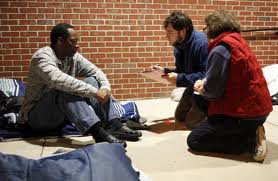 “I didn’t always understand what they were saying, but I just knew they cared about me. That’s why I stayed in the program.”
“I didn’t always understand what they were saying, but I just knew they cared about me. That’s why I stayed in the program.”
The annual fall snapshot survey conducted by the Association of Gospel Rescue Missions consistently reveals that up to 80% of those coming to rescue missions do so because they prefer the spiritual emphasis in the services they receive. If we compare secular and Christian social service agencies, the most significant difference is the people who serve as staff and volunteers.
Before coming to Kansas City, I spent several years as director of licensed, Christ-centered residential treatment facility. Each year in our annual follow-up of program graduates, the comment we heard most was that they knew our staff members sincerely cared about them —and that knowing this truly motivated them to work hard at getting better.
The great “Love Chapter” of the Bible is 1 Corinthians Chapter 13, was written by the Apostle Paul. By looking at verses 4-7, we can see how his definition of love is expressed every day at rescue missions:
A. Love is patient, love is kind… Becoming homeless in some ways amounts to becoming a non-person. It means, essentially, having no social support network. Most homeless individuals have worn out their welcome with family and friends. For them, the patience, kindness and support found at rescue missions is like a breath of fresh air to a suffocating person. A plate of food offered to anyone who is hungry, shelter form the cold, a caring touch from a staff member or volunteer; all of these say “we are here for you.” These simple gestures are often the first connection to a whole new way of life.
B. It is not rude, it is not self-seeking… To those who live on the streets, public scorn and rejection are a daily experience. At rescue missions, no matter where an individual’s problems have taken him or her, they can count on being treated with love and respect. Why? It’s because rescue mission workers don’t just see homeless people as just being where they are today; they also see them as where they could be tomorrow with Christ in their lives.
Over 12,000 people work full-time at AGRM member rescue missions. Additionally, nearly a half million volunteers share their time and talents at rescue missions. Most would say they are there because they have been called by God to serve Him by helping the homeless and needy. This notion of calling, recognizing themselves as conduits of God’s love, makes their service so much more than a job. It makes them instruments in His hands and hurting people are being reached; there were over 130,000 spiritual decisions at rescue missions last alone.
C. It is not easily angered, it keeps no record of wrongs… At rescue missions abundant grace is much in evidence. It is shown in workers who express great patience and forgiveness. AGRM surveys have shown that about one out of five staff members are formerly homeless themselves. As a result, it’s not hard to find someone who has experienced the difficulties of street life — and someone who has been able to move from that lifestyle into a productive and satisfying Christian life.
D. Love does not delight in evil but rejoices with the truth… Too often , rescue missions are viewed only as places where lots of good deeds are practiced — but where the real issues of troubled people are not being addressed. Rescue mission workers know that people usually remain homeless because of addictions, mental problems, and other life controlling issues. So, along with an abundant supply of love and acceptance, most rescue missions have definite strategies in place to help them overcome bondages and other problems. Last year, 14,000 men and women graduated from long-term life-change programs at rescue missions.
E. It always protects, always trusts… One of the fastest growing sectors of the homeless population is children. Now nearly 60% of AGRM member rescue missions have family programs that offer shelter and other services to hundreds of homeless children everyday. At the same time, hundreds of thousands of kids from tough, inner city neighborhoods participate in summer camps and youth activities at member rescue missions. In a very real way, this is homeless intervention, keeping these young lives from future problems that could put them out on the streets.
F. Always hopes, always perseveres… Rescue missions are in the business of serving God and the needy 24 hours a day, 365 days a year. That’s perseverance! Today across North America thousands will line up for meals. Thousands more will sleep in a clean, safe bed, hear the Gospel, study the Bible, and receive needed counseling. As long a Jesus tarries, rescue missions will continue to provide creative and effective help to those in need. It is all done with an eternal purpose in mind, knowing that there is hope for a new and better life through Christ.
See most recent AGRM Statistical Study at www.agrm.org
 When homeless people look to rescue missions for help, they come with a wide variety of needs. These include:
When homeless people look to rescue missions for help, they come with a wide variety of needs. These include:
- food, clothing and shelter
- job counseling and training
- legal assistance
- literacy training and other educational skills
- parenting skills training
- family and couples counseling
- medical care and family planning services
- social support services
- child care during treatment
- psychiatric assessment and mental health services
- help to move into permanent housing
No program has staff with expertise in all of these areas Also, when there is simply no more room in the facility to take additional clients, it is time to make referrals. And, even if a program participant is dismissed for using alcohol or drugs or other disciplinary reasons, making an appropriate referral is a great way to minister to them. Therefore, rescue mission workers need to understand the principles of making good referrals.
A. Knowing When to Make a Referral — Referrals are most commonly made when a client has a need and there are not resources in-house to handle it. Therefore is important to develop an inventory of in-house resources and expertise. Do this by listing the various problems and needs of the people who look to the mission for help. For each area noted, determine who can best assist clients with that particular need. Are their staff members or volunteers who have experience or expertise in financial counseling, for instance.
B. Identifying Referral Resources — People become homeless when they don’t know how to access the resources that are available to them. So, we need to teach our clients how to access needed resources when they encounter problems in their lives. If they learn to do this while staying at the mission, they are more likely to access needed resources once they complete the program. A community referral directory or computer database — complete with phone numbers and contact persons — should be available to rescue mission workers who work directly with program participants. This should include social service agencies, along with churches that are receptive toward mission clients, local professionals, and support groups.
C. Working with Other Agencies – It is always good to list specific individuals at various agencies with whom your ministry has had a favorable contact in the past. Often, asking for a person at the agency by name can help the staff member making the referral to cut through the “red tape” encountered at some agencies. Other rescue missions are important referral resources that are often underutilized. This is especially true for new and smaller missions without established residential recovery programs, other member organizations offer specialized help to people struggling with addiction or families in need of long-term assistance. Using the online directory of missions that are part of the Association of Gospel Rescue Missions is one way to become familiar with some of the innovative programs offered at member rescue missions. Developing an effective referral directory — and keeping it up-to-date can be time-consuming. Therefore, it should be a responsibility assigned to one staff member who will add new resources and confirm the accuracy of current listings.
D. Following Up on Referrals — When referrals are made, there should always be a follow-up contact to the agency. This helps build relationships with referral resources and gives us a direct line on the services that were provided instead of relying on information from the clients themselves. This also keeps clients from being dishonest or manipulative, playing the referral against the program (an visa versa). For the sake of confidentiality and to comply with privacy laws, clients will usually need to sign “release of information” forms that grants the referral source permission to share information with workers at the rescue mission program. To make this sort of arrangement work, all parties involved must have an understanding ahead of time. Tell the individual to whom you are making the referral that you expect the client to grant you this permission. And, tell the client you will be asking them to give it to the mission staff, as well.
These types of arrangements have be benefit of giving mission workers important information about the services clients receive in order to better assist them. It also helps to further develop relationships with other agencies and organizations in the community.



